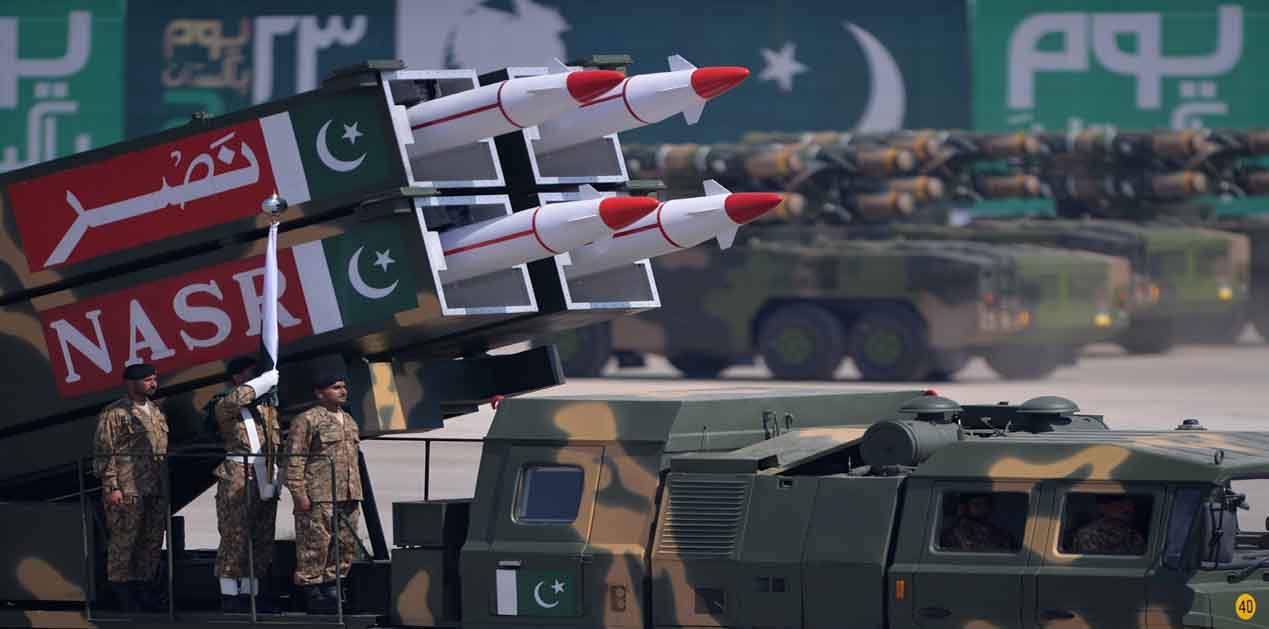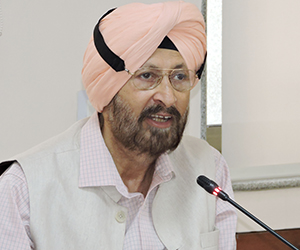While answering a question during a news conference in October 2017, Air Chief Marshal B S Dhanoa, the Chief of Air Staff, said that the air force “has the capability to locate, fix and strike targets across the border,” including tactical nuclear weapons (TNWs).
The Air Chief was stating a fact: The Indian Air Force (IAF) has the technological capability to acquire, engage and destroy all varieties of military targets in Pakistan. This was misinterpreted by the media and commentators to mean that the IAF has plans to “take out” Pakistan’s nuclear warheads. Shortly thereafter, while speaking at a think tank in Washington, D.C., Khawaja M. Asif, Pakistan’s Foreign Minister, said, “If that happens, nobody should expect restraint from us.” Earlier, as Defence Minister, Asif had threatened the use of nuclear weapons at least five times. Holding out nuclear threats, especially threatening the use of TNWs on the battlefield against Indian forces, is part of the Pakistani civilian and military leadership’s DNA.
Disadvantages of TNWs
According to William R. Van Cleave and S. T. Cohen, “… the term tactical nuclear weapons in the closest approximation refers to battlefield nuclear weapons, for battlefield use, and with deployment ranges and yields consistent with such use and confined essentially in each respect to the area of localised military operations.” As part of the nuclear learning that followed the end of the Cold War, it was generally accepted that nuclear exchanges cannot be limited to the battlefield. The use of TNWs even on a small scale is likely to rapidly escalate into full-fledged strategic nuclear exchanges that are both counter value and counter force strikes leading to large-scale death and destruction.
It was also realised that TNWs cannot be effectively employed to bring offensive operations to a grinding halt. For example, one 8-10 Kt low air burst on a combat group moving forward with a frontage and depth of 10-12 km, would cause 30 to 40 personnel casualties and destroy or damage 10 to 12 tanks and ICVs out of 50 to 55. The reserve combat group could resume the advance after a few hours, bypassing the contaminated area. It would be suicidal for Pakistan’s leadership to risk India’s declared massive retaliation response that would follow and destroy Pakistan as a nation state in return for the dubious gains that the use of TNWs might provide.
Examples of the TNWs that were in service with NATO forces included the 8 inch (203 mm) M-110 howitzer and the 155 mm M-109 atomic artillery weapons; and, Lance (120 km, 10-110 Kt) and Honest John (37 km, 5-25 Kt) short-range ballistic missiles (SRBMs). At the upper end of the range scale was the Pershing missile with a range of 160 to 835 km. Besides 152 mm atomic artillery, the Warsaw Pact countries had the FROG and Scud series of rockets and missiles that were nuclear-tipped. Both sides are known to have manufactured some neutron bombs – enhanced radiation weapons – as well. The TNW category of weapons was also known as ‘mini-nukes’.
As a class of weapons, TNWs or battlefield nukes have several major disadvantages:-
• The command and control of TNWs needs to be decentralised at some point during war to enable their timely employment. The delegation of command and control increases the risk of premature and even unauthorised use.
• TNWs are prone to what Henry Kissinger had called the “Mad Major Syndrome” – the unauthorised launch of a nuclear-tipped missile by an officer who is fighting his own war.
• The missile launchers and warheads must be moved frequently from one hide to another to avoid being targeted. Dispersed storage and frequent transportation of the launchers and TNWs under field conditions, increases the risk of accidents.
• When TNWs are mated with the missiles that are mounted on deployed launchers, the warheads are vulnerable to sympathetic detonation on being hit from the air or by artillery fire. This could, in a rare case, lead to a nuclear explosion, causing the adversary to think that the missile battery has been deliberately targeted with a nuclear warhead.
• The safety and security of TNWs is difficult to ensure as these are stored and moved around under field conditions. Hence, these are more vulnerable to Jihadi interception than strategic warheads that are stored under stringent safety and security conditions.
• TNWs are extremely complex weapons and are difficult and expensive to manufacture because of the precision required in engineering (particularly sub-kiloton mini-nukes). They are also difficult to support technically under field conditions.
The lesson that clearly emerges from the foregoing discussion is this: Pakistan’s civilian and military leadership needs to understand that the possession of TNWs for employment on the battlefield is inherently destabilising because it lowers the nuclear threshold and induces a proclivity to use them or lose them.
Pakistan’s Capability to Produce TNWs
Pakistan first tested a short range surface-to-surface multi-tube ballistic missile called Hatf IX (Nasr) on April 19, 2011. According to an ISPR press release, “The missile has been developed to add deterrence value to the strategic weapons development programme at shorter ranges. With a range of 60km, Nasr carries nuclear warheads of appropriate yield with high accuracy and shoot and scoot attributes. This quick response system addresses the need to deter evolving threats.” The carrier vehicle for the missile is an AR1A/A100-E MLRS, procured from China. While the A-100 artillery rocket system has 10 launching tubes for 300 mm diameter rockets (length 7.3 m, weight 840 kg), Pakistan has used the A-100 TEL chassis but replaced the multi-launch tubes, initially with a 2-tube and system and, subsequently, with a 4-tube system.
Dr Rajaram Nagappa of the National Institute of Advanced Studies (NIAS), Bengaluru, has estimated from air and satellite photographs that Nasr’s warhead has a cylindrical section which is 940 mm long and a conical portion which is 660 mm long. His assessment is that Pakistan has the technological capability to produce a TNW to fit in the payload section of the Hatf-9 Nasr SRBM; the warhead is likely to be based on a linear implosion Plutonium (Pu-239) device; and, it is likely to have been cold tested. However, in view of the limited production of Plutonium, the decision on whether to utilise all of it for strategic weapons, or to divert part of the fissile material for TNWs, is a difficult one to make.
Search and Destroy
Is there wisdom in attacking nuclear warhead storage sites and missile launchers during conventional conflict with Pakistan? Or, will such attacks from the air by the IAF’s fighter-ground attack aircraft and from the ground by long-range Indian artillery be destabilising? These are important issues that merit detailed examination.
During the Cold War, the proponents of TNWs had justified their requirement on the grounds that these weapons deter the use of TNWs by the enemy; they provide flexible response over the whole range of possible military threats; they offer nuclear options below the strategic level; they help to defeat large-scale conventional attacks; and, they serve the political purpose of demonstrating commitment to the allies. The opponents of TNWs asserted that these ‘more usable’ weapons would lower the nuclear threshold and make nuclear use more likely. Fears of collateral damage in the extensively populated and developed NATO heartland spurred European opposition to TNWs. Pakistan’s Punjab province has similarly developed terrain and is densely populated.
Those who oppose the targeting of nuclear warhead storage sites and missile launchers argue that if the adversary apprehends that his strategic assets can be destroyed before he can even plan to employ them, it creates a “use them, or lose them” fear psychosis and, consequently, lowers the threshold of the use of nuclear weapons. From India’s point of view, as Pakistan has adopted a first use (in fact, ‘early’ first use) nuclear posture so as to neutralise India’s superiority in conventional military forces and bring India’s Strike Corps offensive operations to a grinding halt, it is in India’s national interest to locate and destroy as many as possible of Pakistan’s nuclear warhead storage sites, missile launchers and their command and control system as early as possible. Also, some of Pakistan’s nuclear-tipped missiles are SRBMs. Hatf-9 (Nasr), for example, has a maximum range of merely 60km. SRBMs like Nasr need to be deployed well forward. As India can never be sure exactly when Pakistan may carry out its threat to hit our leading combat echelons with nuclear warheads, it is necessary to locate and destroy all forward-deployed missile launchers.
Elimination of SRBMs from Nuclear Arsenals?
It is for all of these reasons that India very sensibly decided not to opt for TNWs or nuclear weapons intended for battlefield use. Pakistan would also do well to dismantle its TNWs. In fact, India and Pakistan should mutually agree to retire oldest, first generation, nuclear-capable SRBMs from their strategic arsenals. Pakistan should agree to dismantle Hatf-1, 2 and 3 and India should remove Prithvi-1 and 2 from its nuclear units. All of these SRBMs are obsolescent liquid-fuelled missiles that are due for decommissioning anyway. These are being replaced by more modern solid fuel missiles with a lower CEP. The retirement process of these missiles should be on a reciprocal and transparent basis that is bilaterally verifiable. A good first step might be for both countries to unilaterally declare these nuclear-capable missiles to be non-nuclear delivery systems. The costs and risks for India and Pakistan will be small, but the potential benefits are likely to be immeasurable. Such an agreement will be a nuclear confidence building measure (CBM) of a very high order. It will lead to other, even more important, CBMs being negotiated in due course.
Finally, 50,000 to 60,000 nuclear warheads were produced and stockpiled after Hiroshima and Nagasaki, but some basic human survival instinct “repeatedly stayed the finger that might have pushed the button.” With TNWs mounted on SRBMs once again gaining currency, that may not hold good for very long. Clearly, as a class of weapons, TNWs are well past their use by date.
(The writer is Distinguished Fellow, Institute for Defence Studies and Analyses (IDSA), New Delhi.)
Image Source: http://debuglies.com/2017/03/29/pakistan-plan-to-counter-cold-start-tactical-nuclear-weapons-but-also-conventional-capabilities/











Post new comment